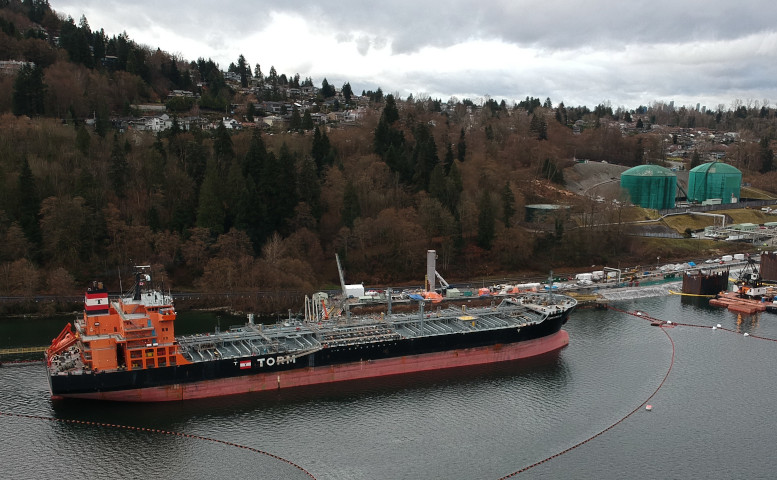Kinder Morgan wants to turn Vancouver into a major bitumen exporting port.
Bill Hopwood outlines the background of the campaign to stop Kinder Morgan’s proposed pipeline and Chris Fofonoff writes about his arrest.
Kinder Morgan’s Proposed Pipeline
The company wants to rebuild its existing pipeline which was built to carry crude oil from Alberta to Burnaby (city beside Vancouver), and from there to local refineries. The proposed pipeline would nearly triple capacity from 300,000 to 850,000 barrels per day and would carry dilute bitumen from the Tar Sands rather than crude oil.
Richard Kinder was the president of Enron but left in 1996, before its systematic fraud was revealed. Kinder, with Bill Morgan an old friend and another former Enron executive, set up Kinder Morgan in 1997, which is now estimated to be the fourth largest energy company in North America, owning 130,000 kilometres of pipelines and 180 terminals. Richard Kinder is estimated to have $11 billion of wealth.
The proposed pipeline has faced mass opposition. Over 100 people were arrested protesting a test drill site in Burnaby (see article below). The Mayors of most of the cities in metro Vancouver are opposed and the First Nations along most of the route are opposed.
The new pipeline would carry bitumen for export to Asia for refining there. It would mean a sevenfold increase in tanker traffic in Vancouver’s harbour. More than one Aframax tanker (245 metres long and 42 metres) a day would sail through the narrow entrance of Vancouver’s harbour and then sail out through the narrow straights to the Pacific Ocean.
The Canadian National Energy Board (NEB) is a government appointed body which is supposed to oversee the approval, construction and operation of pipelines. However, it largely operates as a rubber stamp for Harper’s carbon export agenda. One of the members of the review panel of Kinder Morgan’s proposed pipeline, Marc Eliesen, resigned stating that the “NEB hearing process is a rigged game”. Eliesen is a former head of BC Hydro and was on the board of Suncor Energy. Yet he points out that “This so-called public hearing process has become a farce, and this Board a truly industry captured regulator”. The board has been stacked with oil industry insiders and, symbolic of its closeness to the oil industry, it moved headquarters from Ottawa, the capital of Canada, to Calgary, the capital of the oil industry, in 2014 at a cost of $21 million.
The NEB has given preliminary agreement to Kinder Morgan’s pipeline proposal. The company had to do some tests, which they said involved drilling in a Burnaby city park and conservation area. Kinder Morgan (KM) went in, cut down trees and refused to leave when told to do so by the City of Burnaby. KM got NEB approval to ignore the elected council of Burnaby. When protesters turned up, KM got a court injunction protecting an area around their drill site.
The protesters were then arrested if they crossed into that area, or in few cases were dragged there by the police. The City of Burnaby had to spend at least $1 million for policing an injunction they did not want.
Kinder Morgan is not a company to be trusted. They gave the court the global position coordinates for the area they wanted the protestors excluded from. After 2 weeks it was discovered they had got the GPS wrong – and the Canadian government has confidence that this company can build a pipeline correctly!
They certainly don’t maintain their existing pipelines. The US watchdog, the Pipeline and Hazardous Materials Safety Administration, criticized a long list of KM failings. An article in the Wall Street journal (Sep 27, 2013) asked, “Is Kinder Morgan Scrimping on its Pipelines?”. The article questioned the amount the company spent on maintaining its pipelines, saving money to boost profits. KM has had plenty of spills, leaks and explosions, which have killed at least 7 people in the last decade.
What Kinder Morgan is good at is financial wheeling and dealing. It has recently restructured its various holdings and companies in a move that CEO Richard Kinder stated would give, “a $20-billion tax saving over 14 years.” Already the company only pays $1.5 million in annual taxes in Canada out of earnings of $170 million per year from its existing BC pipeline.
The existing pipeline runs under schools, through farms, towns and cities. There have been spills and leaks along the pipeline. One occurred in the city of Burnaby in 2007 spraying over 230,000 litres of crude oil over a residential area. At least 50 homes were evacuated and a main highway was closed for several days. Some 70,000 litres of oil flowed into the ocean.
If the pipeline goes ahead, it is inevitable that there will be pipeline leaks and a tanker will have a spill. This will devastate ecosystems, kill wildlife, poison rivers and aquifers, destroy farmland and destroy tourism and many other jobs. Once exported and burnt, the bitumen will add to global warning.
However Kinder Morgan, and behind them, Stephen Harper, face a mighty and growing wall of opposition. It shall not pass.
Arrested

It wasn’t my plan to be arrested on the morning of Thursday, November 20th. I’d gotten to the Kinder Morgan (KM) protest site on the west side of Burnaby Mountain just after 7:00 a.m., to find a typically quiet scene, much the same as it had been each of the previous two days after KM’s BC Supreme Court injunction had gone into effect the previous Monday afternoon. There had been perhaps one or two more tarps strung up around the camp’s sole tent, there were a few more shopping bags of food (too much bread, but just the right amount of energy bars), and the sacred First Nations campfire still burning strong. The mood was sleepy but contented, a morning without much of an edge to it. We’d been visited by two officers about a half-hour after I’d arrived. A First Nations “liaison officer” or somesuch, who was remarkable insofar as he was the first First Nations cop I’d seen up there and the only one to be wearing mildly “civilian” clothes; and a White cop with more than a passing resemblance to the milquetoast early-seasons Walter White of Breaking Bad. (I know what I’m talking about, as I met the real Bryan Cranston in New York on my last birthday – a fun, vodka-soaked story for another time.) The two of them shared some inconsequential chatter with us and then left after about 15 minutes. Nothing special – police were up there in all their faux casualness a few times a day. We knew they were scoping the place, and they knew that we knew. Nothing to be done about it.
I helped myself to a banana and croissant (who was taking away all the packaging?, I wondered) and fell into a pleasant conversation around the wood-only sacred fire. I was asked about the thick Paul Robeson biography I was carrying with me, a book I’d set down a couple of years prior for some reason and had only picked back up and started hacking though once again. A few of us sitting there dropped a few comments – nothing too in-depth – about how pleased we all were that the police had not moved in, as some had thought possible, on the very morning after the injunction had come into legal effect. This particular morning, like the two which had preceded it, looked to be another quiet, even boring one. Time – 8:05. Okay, the bus at the bottom of Centennial Way, the road that ran up to the camp, will come by at 8:27. I’ll head down there in ten minutes, and that’ll get me to work right around 9:00.
I can’t remember the name of the 20-something woman who called out from the road about halfway into my ten minutes. I can’t remember her exact words, either, but the message was “They’re here. This is going down, now.” “They” turned out to be around two- or three-dozen RCMP and affiliated officers, fully decked out with reflective vests and holstered firearms. Well, I bet work would’ve been boring today, anyway.
Corporal Cranston was one of the cops in the fore, with Lieutenant Liaison looking somewhat sheepish off to the side. Soon enough, the head officer read aloud the injunction order, as I supposed he was required to do, and told us that anyone who didn’t want to be arrested can walk so-far that-a-way. Protestors were, in between arguing with police and telling them they had no jurisdiction on unceded Squamish lands, rapidly texting and posting and taking video with their phones, mobilizing their networks of friends and supporters to, in the words that I posted to my own Facebook account, “Get up here RIGHT NOW. Not in five minutes, NOW.”
Having taken the slightest of breaks from standing up to neoliberal tyrannical corporate oppression in order to jot my name and phone number on the bookmark of my neglected (and, for the time being, abandoned) Robeson biography, I returned to the action. Just in time to be the ninth in a nine-person wall trying to prevent the police from breaking into the camp itself, a move that, to the surprise of no-one present, proved only very temporarily effective. Our eighteen arms still mostly linked, the young woman who’d raised the initial alarm now called out from our group to implore the cops who had broken in to please respect the still-burning sacred fire (as far as I’m aware, they did, at least at that early time). It was around this moment that I made the solid decision that I’d go to jail today. I was surprisingly unsurprised at my own feeling of calmness in the situation as the nine of us decided, as one, to sit in the mud inside the injunction zone. I knew that I’d be loaded into the paddy-wagon with others to be taken away and “processed”, but at the same time, I knew that I was more-or-less safe. I was, after all, a White male being arrested – hell, I didn’t even have a hippie beard or rainbow scarf as a bulls-eye – and thus I knew I’d be treated with kid-gloves. Hell, I thought, I must be some coward if I’ve got all these privileges and back out now. It’s not like I was the First Nations protestor I’d heard they’d beaten a couple of weeks before. Or the White hippie guy they’d shot out of a tree with beanbag rounds just an hour or two later. I was pretty exalted, under the circumstances.
I had in mind, grandiosely, the Black American civil-rights protestors of the 1950s and ’60s when I volunteered to be the first person (of the second group, as three of our little coterie had been forcibly removed from us and hauled away over a half-hour before) to be arrested. I chose to walk by my own power to the police van to emphasize that I was being placed under arrest by my own volition as a rational, sane citizen of the free world. (I should note here, since it sounds the opposite, that I have nothing but respect for those who chose to have themselves taken into custody in other ways – ways which universally required more physical gumption and courage than did mine. Nothing that I mention about my own course of action should be understood to contradict that.) There was simply something that appealed to me about an average person walking, unafraid and with dignity (and mud on his pants), off to the clink. I suppose I want this sort of thing to become normalized, to demonstrate to the larger public that defiance of the law is not the exclusive domain of some kind of stereotypical public construct of modern-day flower children or mask-wearing, black-clad anarchists (in spite of my own generally sympathetic feelings toward those kinds of folk). So-called “everyday people” (take that to mean what you will), even those who have had little or no involvement with politics in the past, must be reached and energized to oppose this pipeline – and other pipelines, and the general rule of injustice in society – in greater numbers, and then to each become more dedicated to these causes instead of simply going and staying home at the close of one protest rally. This is a principle which I must also heed, myself.
(Going rather against this “larger tent” concept, I also raised my right fist in the air as I was being gently led away by my left arm, and this was the image of me that most made the news sites. It was the first time in my life, I soon came to realize, that I felt I’d actually somewhat earned the right to use that old, versatile salute and not feel like a poseur.)
As about eight of us waited in the metal box of the police van (three men in the small front compartment, five women in the larger back one), a First Nations fellow by the name of Adam, sitting next to me, led us in the First Nations “Women’s Warrior Song”, which I’d heard at various protests in the past but had never participated in for at least two reasons. But hell, the eight of us, from many different backgrounds, had done something positive together and we hoped that our fellow protestors (and the news cameras) outside were hearing us and taking heart and picking us up on their microphones.
After my mugshot was taken and my plastic handcuffs cut off (we were all somewhat miffed that we didn’t merit proper metal ones), I signed a promise to appear in court in January to face civil contempt-of-court charges (for violating a court injunction). Also I was informed as to where near the worksite I could not go (the answer was essentially “the same as everyone else”) and a group of us went back up the mountain. The police had taped off the injunction zone and the now-much-larger crowd were around the outside in various states of justifiable agitation. And the police, as they will tend to do, declared that the zone was now expanding and they advanced shoulder-to-shoulder, shoving the wall of protestors back, occasionally interrupting the relative monotony of the task by choosing a citizen to choke or to pull violently out of the line to arrest. Pretty pedestrian stuff, really.
The officer who’d “processed” me and told me that I was perfectly permitted to return as long as I stayed on the east side of the road (a condition I had fastidiously observed) was now one of those who were pushing me off of the east side of the road! I swear, when I pointed this out to him, he looked just the tiniest bit ashamed for having lied to me. I guess I’ll take what I can get.
Having returned at least once on each of the subsequent eight days, it was certainly an interesting experience to not be blinded by the drilling company’s night-splitting work-lights as I walked up Centennial after work on the evening of the 28th. Kinder Morgan’s lawyer had, earlier that day, been forced to admit that the GPS co-ordinates of the injunction zone were completely incorrect – off by as much as 30 metres compared with the zone as it existed behind the police tape (the injunction zone was itself only 25 metres across; therefore, the injunction zone was off by about one injunction zone). The judge also cancelled all 100 or so civil contempt of court charges, including mine. Turns out it was a freebie! (Criminal charges, including some for allegedly assaulting officers, remained after the ruling. No police were charged.) The drilling crews had left and taken their equipment earlier that day. Kinder Morgan told the public that, actually, they had all the drilling data they needed—this in spite of the fact that the company had just asked the court to extend the injunction by 11 days. Still, this extension of the injunction had been rejected and the civil charges were no more. Most of us felt we could declare this step a qualified victory.
Now we have to decide – not just wait and see – what the next steps entail.
For more information, you can follow “Burnaby Mountain Updates” on Facebook.



